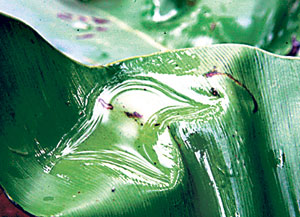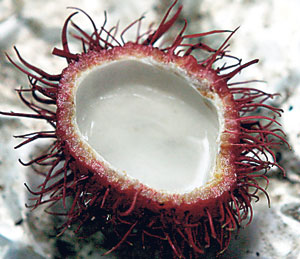Mea culpa or “it’s my own fault” is what both the authorities and the public must say as the death toll rises and dengue, spread by a tiny mosquito, widens and tightens its vice-like grip on Sri Lanka.
At the last count about 146 men, women and children had died and 12,300 were sick with dengue.
Since the first deaths were reported in January and February, there has been much talk but what is the ground reality, five months later? Ironically, the Sunday Times in an article titled ‘Wake up, dengue on the prowl’ on February 15 alerted the nation to the scourge of dengue.
Year in, year out, we have grappled with dengue but have not been able to put our might against this tiny vector and any serious and concerted dengue campaign should start at the point of accepting that so far we have failed in our attempts.
What has gone wrong?
There is no coordination among all relevant authorities on this issue of national importance and only ad hoc programmes are carried out whenever there is a crisis, was the view expressed by many including the public.
 |
| The little water in coconut leaves where eggs are laid. |
The next question which arises then is: Who are the authorities who must play the pivotal role not only in preventing but also controlling dengue. At the forefront in the dengue battle has been the Health Ministry, but should the onerous task with regard to this national health hazard be its responsibility only?
The Health Ministry should carry out awareness campaigns, through its Epidemiology Unit, National Dengue Control Unit and army of community-level public health personnel such as Medical Officers of Health (MOHs) and Public Health Inspectors (PHIs), among the public on the dangers of dengue and how to safeguard homes, offices and schools.
On the other hand, once people are infected with dengue, it is the ministry’s task through its doctors and hospitals to manage them and ensure as far as possible that they are cured and do not leave in coffins. However, the two other crucial authorities are the local government bodies coming under the Ministry of Local Government and Provincial Councils and the Ministry of Environment.
As both dengue and environmental experts pointed out that climatic changes have resulted in a rapid rise in the number of dengue cases not only in Sri Lanka but also worldwide, one expert explained that the lifespan of the dengue mosquito had increased. “Usually, the lifespan is three weeks but now it is 4-6 weeks, allowing more bites by these mosquitoes for a longer period, leading to a spread of the disease. This also gives the female mosquito more time to lay more eggs,” one expert explained.
Stressing that the actual number of dengue patients may be as high as 30,000, Government Medical Officers’ Association (GMOA) Assistant Secretary Dr. Upul Gunasekara pointed out that many would be seeking treatment at private hospitals whereas the figures were only from the state hospitals. “In 2004, there were 88 deaths, after which the problem subsided in the next few years only to rear its head again this year,” he said, adding that the Dengue Control Act, though brought in with good intentions was not practical.
 |
| Banana leaf where the mosquito has laid eggs. |
Dealing with several flaws in the Act, enforced with a vengeance in June this year, Dr. Gunasekera pointed out that usually the public is very receptive to advice and guidance from grassroots level health officers and workers. The earlier procedure was to make public announcements about a dengue threat and organize clean-up programmes. “People would take the MOH to spots they suspected could be mosquito breeding grounds and clean up the area.”
What has happened with the stringent implementation of the Act is that the PHI requires written consent from the house or land owner for a specific day for inspection, then if there is a problem, the owner has to be given time to clean-up, the PHIs have to go back on another day, he said detailing the procedure. “By then about 28 days have passed and the mosquitoes have laid eggs many times and some of those eggs have also hatched.”
The Act is not practical because all stakeholders were not consulted, he said, pointing out that it seems to have been drawn up by someone who was not even aware of the mosquitoes’ lifecycle. Challenging the thinking that the GMOA should have stepped in when public opinion was called on the proposed Act, Dr. Gunasekera said as the main stakeholder in the health sector, the GMOA should have been consulted and been part and parcel of the process before that.
Agreeing, however, that freeing or at least curbing dengue in Sri Lanka should not be the mandate of the Health Ministry alone, he said other authorities too had to take responsibility and play their role.
“There seems to be an administrative failure,” he said, adding that authorities such as the Ministries of Local Government, Environment and Education should be part of the group. “MOHs and PHIs can educate the public, but the local bodies must clear the garbage, the environment authorities must find solutions to the rubbish issue and the education authorities must chip in and instruct schools on a routine basis about cleanliness. The people too should see a qualified doctor and seek immediate treatment at a government hospital if they are sick.”
 |
| Half peel of a rambuttan is a convenient
breeding spot |
With regard to prevention, take a leaf from Cuba where dengue has been eradicated, he urged, adding that a Task Force should be set up not only with medical and other experts but also people with a knowledge of technology to fight the dengue mosquito. It is bacteria which is not harmful to humans that are being used to fight the menace in Cuba. We need to look at the eradication programme and adapt it to suit our needs.
“It was after the 2004 dengue epidemic that the Health Ministry decided to set up a separate Dengue Control Unit which is working closely with the Epidemiology Unit,” said an expert adding that they have undertaken a concerted awareness campaign among the public and clean-up programmes in schools etc since 2005 in addition to the training of health personnel. Extra machines which are needed to check the packed cell volume (PCV) which is indicative of a patient being in danger from dengue have been distributed to hospitals in the high-risk areas to better manage patients, the Sunday Times learns.
Reiterating that climatic changes have led to an increase in the disease, the expert said that the public also needs to be vigilant all the time and not only during an epidemic. “They are aware of what they should do,” the expert said, “but forget the problem after the epidemic is over. Once dengue is controlled, households and offices go back to their old ways.” With the monsoon rains, comes dengue. In January and February this year, the disease followed the usual low line in the graph but rose drastically in May, similar to the global pattern, the expert said. Now 13 high-risk districts have been identified.When asked about the Cuban model put forward by the GMOA, the expert said, the breeding places of the dengue mosquito would not only differ from country to country but also from district to district even in a single country.
In Cuba, the mosquito bred in water storage tanks, whereas in Sri Lanka the problem is mostly with small containers around households.Conceding that dengue has become a national problem, Local Government and Provincial Councils Minister Janaka Bandara Tennakoon agreed that urgent preventive measures are a must. A circular was issued on June 4 to local government officials such as Provincial Commissioners, Divisional Secretaries, Mayors etc directing them to implement preventive measures with the support of the police and the public, he said. There is a lack of public awareness even in terms of the very basics about where and how the dengue mosquito breeds, the Minister stressed.
Explaining the action taken so far, he said that under the Emergency Regulations, the government has decided to take over the garbage dumps and implement disposal/recycling methods to prevent these landfills themselves turning into mosquito-breeding grounds.
Analysing the current epidemic, Environment Minister Champika Ranawaka said 35% of those affected are housewives and 28% schoolchildren. This is a clear indication that the mosquito breeding grounds are in homes and schools. “The main contributory factors for dengue are rain and urbanization,” he explained adding that, “people must be vigilant about water collections, however small.” Dealing at length with the garbage issue, Mr. Ranawaka said that proper landfills should have been demarcated 40 years ago. There were several barriers to solving the garbage problem such as demarcating landfills and legal issues connected to the few landfills already demarcated.
There has been no planning, he said, adding that the Urban Development Authority (UDA) has not zoned the cities in a systematic manner. There should be commercial and residential areas as well as zones to dump, dispose and recycle garbage. Otherwise, where do you put the garbage generated in large cities like Colombo? Commending the government’s move to acquire garbage dumps under Emergency Regulations as “positive”, the Minister said the plan is to rehabilitate such landfills. For, most of the landfills were embroiled in legal action either between the local government body and the people living in the surrounding area or the companies which have been given long-term contracts to dispose of and recycle the dumped garbage.
Garbage collection, disposal and recycling fall under the mandate of the local government authorities. “Some do it well, some do it badly while some lack the capacity to do it,” he said, stressing that the only way the Environmental Ministry can get involved is by filing action against local government bodies with regard to garbage collection.
“We have the funds and technical know-how to help any local government body which comes up with a good project proposal for garbage disposal,” he said pointing out Bandaragama, Balangoda, Negombo of 76 areas which had taken up the ministry’s offer and were dealing with their garbage. He assured the public that the large garbage-dumping skippers which were removed from key points due to security reasons may be put in place again.
“We have asked for security clearance to re-install them, so that the public can dump their garbage in them rather than on the road.”
Hopefully, all these measures will ensure that deaths from dengue will be prevented next year at least, while reining-in the disease at least now this year. Sri Lanka must get on a war-footing to battle this tiny mosquito through a multi-sectoral approach and prevent unnecessary deaths.
Why so virulent?
Four strains, DEN-1, DEN-2, DEN-3 and DEN-4, can cause both Dengue Fever and Dengue Haemorrhagic Fever.
Infection with one strain provides immunity only to that strain, said a doctor, adding that in fact if you contract another strain, the antibodies created in your system by the first infection makes the second time round more virulent.
Prevention is the key
Did you know that once the dengue mosquitoes (Aedes aegypti and Aedes albopictus) lay eggs on the surface, just above the water-line of a container carrying clean water, even if the water evaporates, the eggs don’t die?
If a drop of water falls on the eggs even a year later, they will hatch releasing the larvae which grows into the adult mosquito, the Sunday Times learns. And the scary part is that the mosquito will feel the side of any container and if it is smooth lay eggs on that surface even with a few drops of water – a yoghurt cup, a small plastic container, the rigi-foam container in which lunches are sold, a flower vase, a polythene bag atop a small garbage, a leaf which has been blown to the ground by the wind, the half peel of a rambutan, a discarded thambili, a tyre thrown up on the roof to hold down a plastic sheet, an uncovered water-collecting bucket, a blocked gutter …..the list goes on.
Before you discard small containers such as yoghurt cups or even rigi-foam boxes, crush them and don’t put them in the open for water to collect, advised a doctor, adding that throwing out the water in a flower vase, bird-bath or the pots near our front-doors which hold flowers is not good enough. “You must scrub the sides of the vase, bird-bath or pot well to ensure that you destroy the eggs.”
With regard to control measures a country can adopt, an expert said that adult mosquitoes can be destroyed by fogging but that is just not enough. At the same time measures must be taken to destroy the larvae and the eggs as well by introducing chemicals The fogging too must target the bodies of each and every mosquito, to be successful and it has to be done continuously. The chances are that other insects vital for the eco-system will also be destroyed, the expert said. Fogging would be suitable for areas where there is a high density of mosquitoes..
The larvae and the eggs can only be destroyed by introducing chemicals to the water. Can you do it to every small container lying around, the expert asked and what of the side-effects on humans? Therefore, the best way is to rid your surroundings of breeding places.
|



